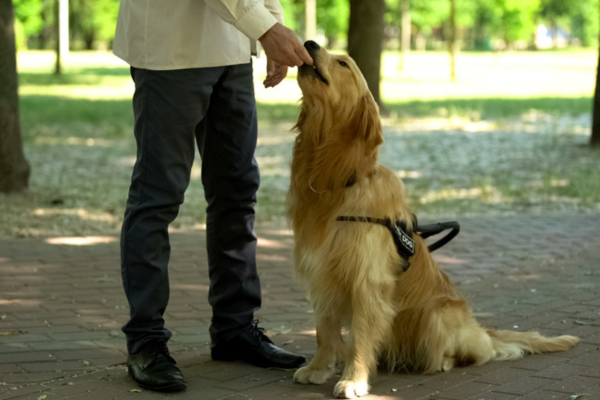Service dogs are essential in assisting individuals with disabilities, enabling them to navigate daily life with greater independence and confidence. While these highly trained animals are remarkable, their effectiveness relies heavily on the public’s understanding of how to interact—or, more importantly, not interact—with them. Recognizing service dog signals and knowing when to give space is critical for supporting the handler’s needs and respecting the dog’s work.
Why Service Dogs Need Space
Service dogs are not pets; they are working animals trained to perform specific tasks for their handler, such as guiding them through crowded spaces, alerting them to medical emergencies, or providing physical support. Interruptions, distractions, or crowding around a service dog can:
-
Disrupt their focus
A distracted service dog might miss crucial cues from their handler. Repeated distractions can erode the trust between the handler and the service dog. This can make it harder for the handler to rely on their dog and negatively impact their overall quality of life.
-
Jeopardize safety
When a service dog cannot perform its tasks effectively, it can put both the handler and the dog at risk. For example, a medical alert dog could miss a critical blood sugar drop from their handler, risking the handler’s well-being.
-
Increase stress
Crowding or unwanted attention can cause anxiety for the service dog and the handler. This can negatively impact their overall well-being and make it more difficult for the handler to manage their disability.
Recognizing Service Dog Signals
Service dogs often wear gear (though not required) or exhibit behavior indicating they are on duty. Some of these include:
-
Vests or Harnesses
Service dogs sometimes wear vests or harnesses that identify them as working animals. These garments typically feature patches, embroidery, or tags that state “Service Dog” or “Do Not Pet.” While not legally required, these items serve several purposes. Primarily, they visually communicate to the public that the dog is actively assisting its handler and should not be distracted. This gear helps minimize interruptions and lets the dog focus on its job.
-
Focused Behavior
Service dogs exhibit highly focused behavior when working. They remain incredibly attentive to their handler’s needs and environment, minimizing distractions. Depending on the dog’s specific tasks, this focused behavior manifests in various ways. Guide dogs, for example, meticulously navigate obstacles and guide their handlers safely. Seizure alert dogs remain vigilant, constantly monitoring their handler for signs of an impending seizure. These behaviors result from rigorous training and demonstrate the incredible bond and trust between the handler and their service dog.
-
Handler Cues
Handlers may use subtle cues to communicate with their service dogs. These cues can include hand gestures, slight movements, or even changes in posture. For example, a handler might gently nudge their dog in a particular direction, use a specific hand signal to guide them around an obstacle, or subtly shift their weight to indicate a change in direction. These cues are often subtle and may not be immediately apparent to an outside observer, but they are essential for effective communication between the handler and their service dog.
When to Give Space
Service dogs and their handlers should always be treated with the utmost respect and provided the space they need to operate safely and effectively. There are some particular situations where space is especially critical:
-
In Crowded Areas
Crowded areas can be particularly challenging for service dogs. The increased noise, movement, and distractions can easily overwhelm them and hinder their ability to perform tasks. For example, a guide dog may struggle to navigate a crowded sidewalk if people constantly try to pet or distract them. Similarly, a service dog assisting someone with mobility issues may struggle to maneuver through a crowd of people who continuously bump into them or block their path.
-
During Tasks or Alerts
When a service dog is actively performing a task or giving an alert, it’s crucial to avoid distractions at all costs. These moments are critical for the handler’s safety and well-being. If a medical alert dog signals an impending seizure, any distractions could delay the handler’s response and worsen the situation. Respecting the dog’s focus during these critical moments is paramount and can significantly impact the handler’s safety and independence.
-
If the Handler Asks
When a service dog handler requests space, it’s essential to honor that request. This allows the dog to focus on its tasks, whether guiding a visually impaired individual, alerting to medical emergencies, or providing stability for someone with mobility issues. Respecting these requests demonstrates a commitment to inclusivity and ensures that individuals with disabilities can navigate the world with the support of their trained partners.
How to Respect Service Dogs and Their Handlers
-
Do Not Pet or Distract the Service Dog
No matter how tempting, resist the urge to pet, call, or interact with a service dog. Even a momentary distraction can interfere with its work.
-
Speak to the Handler, Not the Dog
If you need to interact with the handler, direct your attention to them, not the dog. It’s unfair to the dog and its handler to potentially distract the service dog.
-
Keep Your Pets at a Distance
When walking your pet near a service dog, maintain a safe distance to avoid unnecessary interaction or distraction. No matter how badly your pet may want to interact with a service dog, you must keep your distance.
-
Ask Questions Respectfully
If you’re curious about the dog’s role, wait for an appropriate moment and ask the handler politely. If they do not always have the time or desire to explain, or you cannot ask a handler your questions, there are many valuable resources online to consult, including our website!
The Importance of Public Awareness
Educating yourself and others about service dog etiquette is a simple yet powerful way to support individuals with disabilities. By understanding service dog signals and knowing when to give space, you contribute to a safer, more inclusive environment for everyone.
Next time you see a service dog, remember to admire their dedication from afar and respect their vital work. It’s a small effort that makes a big difference.
Explore our other resources for more tips on service dog etiquette and advocacy. Together, we can build a community that respects and supports service dog teams!


